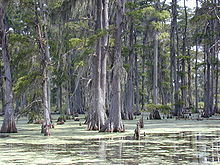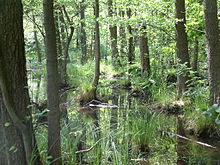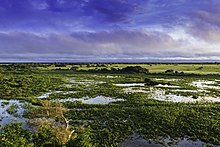| It has been suggested that this article be split into articles titled Swamp (wetland) and Swamp (woodland). (discuss) (July 2023) |

A swamp is a forested wetland. Swamps are considered to be transition zones because both land and water play a role in creating this environment. Swamps vary in size and are located all around the world. The water of a swamp may be fresh water, brackish water, or seawater. Freshwater swamps form along large rivers or lakes where they are critically dependent upon rainwater and seasonal flooding to maintain natural water level fluctuations. Saltwater swamps are found along tropical and subtropical coastlines. Some swamps have hammocks, or dry-land protrusions, covered by aquatic vegetation, or vegetation that tolerates periodic inundation or soil saturation. The two main types of swamp are "true" or swamp forests and "transitional" or shrub swamps. In the boreal regions of Canada, the word swamp is colloquially used for what is more formally termed a bog, fen, or muskeg. Some of the world's largest swamps are found along major rivers such as the Amazon, the Mississippi, and the Congo.
Differences between marshes and swamps

Swamps and marshes are specific types of wetlands that form along waterbodies containing rich, hydric soils. Marshes are wetlands, continually or frequently flooded by nearby running bodies of water, that are dominated by emergent soft-stem vegetation and herbaceous plants. Swamps are wetlands consisting of saturated soils or standing water and are dominated by water-tolerant woody vegetation such as shrubs, bushes, and trees.
Hydrology
Swamps are characterized by their saturated soils and slow-moving waters. The water that accumulates in swamps comes from a variety of sources including precipitation, groundwater, tides and/or freshwater flooding. These hydrologic pathways all contribute to how energy and nutrients flow in and out of the ecosystem. As water flows through the swamp, nutrients, sediment and pollutants are naturally filtered out. Chemicals like phosphorus and nitrogen that end up in waterways get absorbed and used by the aquatic plants within the swamp, purifying the water. Any remaining or excess chemicals present will accumulate at the bottom of the swamp, being removed from the water and buried within the sediment. The biogeochemical environment of a swamp is dependent on its hydrology, affecting the levels and availability of resources like oxygen, nutrients, water pH and toxicity, which will influence the whole ecosystem.
Values and ecosystem services

Swamps and other wetlands have traditionally held a very low property value compared to fields, prairies, or woodlands. They have a reputation for being unproductive land that cannot easily be utilized for human activities, other than hunting, trapping, or fishing. Farmers, for example, typically drained swamps next to their fields so as to gain more land usable for planting crops, both historically, and to a lesser extent, presently. On the other hand, swamps can (and do) play a beneficial ecological role in the overall functions of the natural environment and provide a variety of resources that many species depend on. Swamps and other wetlands have shown to be a natural form of flood management and defense against flooding. In such circumstances where flooding does occur, swamps absorb and use the excess water within the wetland, preventing it from traveling and flooding surrounding areas. Dense vegetation within the swamp also provides soil stability to the land, holding soils and sediment in place whilst preventing erosion and land loss. Swamps are an abundant and valuable source of fresh water and oxygen for all life, and they are often breeding grounds for a wide variety of species. Floodplain swamps are an important resource in the production and distribution of fish. Two thirds of global fish and shellfish are commercially harvested and dependent on wetlands.
Impacts and conservation
Historically, humans have been known to drain and/or fill swamps and other wetlands in order to create more space for human development and to reduce the threat of diseases borne by swamp insects. Wetlands are removed and replaced with land that is then used for things like agriculture, real estate, and recreational uses. Many swamps have also undergone intensive logging and farming, requiring the construction of drainage ditches and canals. These ditches and canals contributed to drainage and, along the coast, allowed salt water to intrude, converting swamps to marsh or even to open water. Large areas of swamp were therefore lost or degraded. Louisiana provides a classic example of wetland loss from these combined factors. Europe has likely lost nearly half its wetlands. New Zealand lost 90 percent of its wetlands over a period of 150 years. Ecologists recognize that swamps provide ecological services including flood control, fish production, water purification, carbon storage, and wildlife habitats. In many parts of the world authorities protect swamps. In parts of Europe and North America, swamp restoration projects are becoming widespread. The United States government began enforcing stricter laws and management programs in the 1970s in efforts to protect and restore these ecosystems. Often the simplest steps to restoring swamps involve plugging drainage ditches and removing levees.
Conservationists work to preserve swamps such as those in northwest Indiana in the United States Midwest that were preserved as part of the Indiana Dunes.
Notable examples
Swamps can be found on all continents except Antarctica.
The largest swamp in the world is the Amazon River floodplain, which is particularly significant for its large number of fish and tree species.
Africa
The Sudd and the Okavango Delta are Africa's best known marshland areas. The Bangweulu Floodplains make up Africa's largest swamp.
Asia

The Mesopotamian Marshes is a large swamp and river system in southern Iraq, traditionally inhabited in part by the Marsh Arabs.
In Asia, tropical peat swamps are located in mainland East Asia and Southeast Asia. In Southeast Asia, peatlands are mainly found in low altitude coastal and sub-coastal areas and extend inland for distance more than 100 km (62 mi) along river valleys and across watersheds. They are mostly to be found on the coasts of East Sumatra, Kalimantan (Central, East, South and West Kalimantan provinces), West Papua, Papua New Guinea, Brunei, Peninsular Malaya, Sabah, Sarawak, Southeast Thailand, and the Philippines (Riley et al.,1996). Indonesia has the largest area of tropical peatland. Of the total 440,000 km (170,000 sq mi) tropical peat swamp, about 210,000 km (81,000 sq mi) are located in Indonesia (Page, 2001; Wahyunto, 2006).
The Vasyugan Swamp is a large swamp in the western Siberia area of the Russian Federation. This is one of the largest swamps in the world, covering an area larger than Switzerland.
North America

The Atchafalaya Swamp at the lower end of the Mississippi River is the largest swamp in the United States. It is an important example of the southern cypress swamp but it has been greatly altered by logging, drainage, and levee construction. Other famous swamps in the United States are the forested portions of the Everglades, Okefenokee Swamp, Barley Barber Swamp, Great Cypress Swamp and the Great Dismal Swamp. The Okefenokee is located in extreme southeastern Georgia and extends slightly into northeastern Florida. The Great Cypress Swamp is mostly in Delaware, but extends into Maryland on the Delmarva Peninsula. Point Lookout State Park on the southern tip of Maryland contains many swamps and marshes. The Great Dismal Swamp lies in extreme southeastern Virginia and extreme northeastern North Carolina. Both are National Wildlife Refuges. Another swamp area, Reelfoot Lake of extreme western Tennessee and Kentucky, was created by the 1811–12 New Madrid earthquakes. Caddo Lake, the Great Dismal and Reelfoot are swamps centered at large lakes. Swamps are often associated with bayous in the southeastern United States, especially in the Gulf Coast region. A baygall is a type of swamp found in the forest of the Gulf Coast states in the USA.
List of major swamps


The world's largest wetlands include significant areas of swamp, such as in the Amazon and Congo River basins. Further north, however, the largest wetlands are bogs.
Africa
- Bangweulu Swamps, Zambia
- Mare aux Songes, Mauritius*
- Niger Delta, Nigeria
- Okavango Swamp, Botswana
- Sudd, South Sudan
Asia
- Asmat Swamp, Indonesia
- Candaba Swamp in Apalit and Candaba, Pampanga and Pulilan, Bulacan, Philippines
- Mangrove Swamp in Karachi, Pakistan
- Myristica Swamp in Western Ghats, India
- Ratargul Swamp Forest in Sylhet, Bangladesh
- Sundarbans in India and Bangladesh
- Vasyugan Swamp, Russia
- Negombo Swamp, Sri Lanka
Australia
- Banksia Swamp, Victoria, Australia
- Becher Point Wetlands, Western Australia
- Burraga Swamp, New South Wales, Australia
- Coomonderry Swamp
- Coastal Swamp Oak Forest, Queensland/New South Wales, Australia
- Coastal Upland Swamps, New South Wales, Australia
- Cumbung Swamp, New South Wales, Australia
- Fivebough and Tuckerbil Swamps, New South Wales, Australia
- Koo-Wee-Rup Swamp, Victoria, Australia
- Noosa Everglades, Queensland, Australia
- Toolibin Lake, Western Australia
- West Melbourne Swamp, Victoria, Australia
Europe

- Pripyat Marshes, Belarus
- Šúr, Slovakia
- Kopački rit, Croatia
North America
- Atchafalaya National Wildlife Refuge, Louisiana, United States
- Big Cypress National Preserve, Florida, United States
- Barley Barber Swamp, Florida, United States
- Cache River, Illinois, United States
- Caddo Lake, Texas/Louisiana, United States
- Cibuco Swamp, Puerto Rico
- Congaree Swamp, South Carolina, United States
- Everglades, Florida, United States
- First Landing State Park, Virginia, United States
- Grand Kankakee Marsh, Indiana, United States
- Great Black Swamp, Indiana/Ohio, United States
- Great Cypress Swamp, Delaware and Maryland, United States, also known as Great Pocomoke Swamp
- Great Dismal Swamp, North Carolina/Virginia, United States
- Great Swamp National Wildlife Refuge, New Jersey, United States
- Green Swamp, Florida, United States
- Green Swamp, North Carolina, United States
- Honey Island Swamp, Louisiana, United States
- Hudson Bay Lowlands, Ontario, Canada
- Limberlost, Indiana, United States
- Louisiana swamplands, Louisiana, United States
- Mingo National Wildlife Refuge, Puxico, Missouri, United States
- Mobile-Tensaw River Delta, Alabama, United States
- Okefenokee Swamp, Georgia/Florida, United States
- Pantanos de Centla, Tabasco/Campeche, Mexico
- Reelfoot Lake, Tennessee/Kentucky, United States
- Texas Swamplands, Texas, United States
- Tortuguero National Park, Limón, Costa Rica
South America

- Caribbean Lowlands, Colombia
- Esteros del Iberá, Argentina
- Lahuen Ñadi, Chile
- Pantanal, Brazil, Bolivia and Paraguay
- Paraná Delta, Argentina
See also
- Aquatic plant – Plant that has adapted to living in an aquatic environment
- Bayou – Body of water in flat, low-lying areas
- Bog – Type of wetland with peat-rich soil
- Coniferous swamp – Forested wetlands dominated by conifers
- Fen – Type of wetland fed by mineral-rich ground or surface water
- Freshwater swamp forest – Forest growing on an alluvial zone
- Hydrogen sulfide – Poisonous, corrosive and flammable gas
- Marsh – Low-lying and seasonally waterlogged land
- Marsh gas – Gas produced naturally within marshes, swamps and bogs
- Muck – Soil typePages displaying short descriptions of redirect targets
- Peat – Accumulation of partially decayed vegetation
- Peat swamp forest – Tropical moist forests where waterlogged soil prevents dead leaves and wood from fully decomposing
- Salt marsh – Coastal ecosystem between land and open saltwater that is regularly flooded
- Shrub swamp – type of wetland ecosystemPages displaying wikidata descriptions as a fallback
- Slough (hydrology) – Type of wetland
- Wetland – Type of land area that is flooded or saturated with water
- Will-o'-the-wisp – Atmospheric ghost lights
References
- ^ Keddy, P.A. 2010. Wetland Ecology: Principles and Conservation (2nd edition). Cambridge University Press, Cambridge, UK. 497 p.
- ^ "swamp". National Geographic Society. 2011-01-21. Archived from the original on 2021-03-03. Retrieved 2019-09-26.
- ^ Hughes, F.M.R. (ed.). 2003. The Flooded Forest: Guidance for policy makers and river managers in Europe on the restoration of floodplain forests. FLOBAR2, Department of Geography, University of Cambridge, Cambridge, UK. 96 p.
- ^ Mitsch, W.J., & Gosselink, J.G.(2015). Wetlands. Hoboken, NJ: John Wiley & Sons Inc.
- Swamp Archived 2007-06-10 at the Wayback Machine (from glossary web page of the United States Geological Survey)
- Keddy, P.A., L.H. Fraser, A.I. Solomeshch, W.J. Junk, D.R. Campbell, M.T.K. Arroyo and C.J.R. Alho. 2009. Wet and wonderful: the world's largest wetlands are conservation priorities. BioScience 59: 39–51.
- "Swamps". Nature Works- New Hampshire PBS. Archived from the original on 2019-11-12. Retrieved 2019-11-26.
- ^ "Classification and Types of Wetlands". EPA. 9 April 2015. Archived from the original on 23 November 2019. Retrieved 26 November 2019.
- "Linnaistensuo Mire". Visit Lahti. Lahti Region. Archived from the original on 1 December 2021. Retrieved 18 November 2020.
- Lowe-McConnell, R. H. (1975). Fish Communities in Tropical Fresh waters: Their Distribution, Ecology and Evolution. London: Long man
- Keddy, P.A., D. Campbell, T. McFalls, G. Shaffer, R. Moreau, C. Dranguet, and R. Heleniak. 2007. The wetlands of lakes Pontchartrain and Maurepas: past, present and future. Environmental Reviews 15: 1–35.
- Dugan, P. (ed.) 2005. Guide to Wetlands. Buffalo, New York. Firefly Books. 304 p.
- Peters, M. and Clarkson, B. 2010. Wetland Restoration: A Handbook for New Zealand Freshwater Systems. Manaaki Whenua Press, Lincoln, N.Z. ISBN 978-0-478-34707-4 (online)
- Environment Canada. 2004. How Much Habitat is Enough? A Framework for Guiding Habitat Rehabilitation in Great Lakes Areas of Concern. 2nd ed. 81 p.
- Smith, S. & Mark, S. (2006). Alice Gray, Dorothy Buell, and Naomi Svihla: Preservationists of Ogden Dunes. The South Shore Journal, 1. "South Shore Journal - Alice Gray, Dorothy Buell, and Naomi Svihla: Preservationists of Ogden Dunes". Archived from the original on 2012-09-13. Retrieved 2012-06-11.
- Smith, S. & Mark, S. (2009). The Historical Roots of the Nature Conservancy in the Northwest Indiana/Chicagoland Region: From Science to Preservation. The South Shore Journal, 3. "South Shore Journal - the Historical Roots of the Nature Conservancy in the Northwest Indiana/Chicagoland Region: From Science to Preservation". Archived from the original on 2016-01-01. Retrieved 2015-11-22.
- Smith, S. & Mark, S. (2007). The cultural impact of a museum in a small community: The Hour Glass of Ogden Dunes. The South Shore Journal, 2. "South Shore Journal - the Cultural Impact of a Museum in a Small Community: The Hour Glass in Ogden Dunes". Archived from the original on 2012-11-30. Retrieved 2012-06-11.
- Hunter, Malcolm L. (1999). Maintaining Biodiversity in Forest Ecosystems. Cambridge University Press. p. 325. ISBN 978-0521637688.
- Goulding, M. (1980). The Fishes and the Forest: Explorations in Amazonian Natural History. Berkeley, CA: University of California Press.
- Lowe-McConnell, R. H. (1975). Fish Communities in Tropical Freshwaters: Their Distribution, Ecology and Evolution. London: Longman
- ^ L.H. Fraser and P.A. Keddy (eds.). 2005. The World's Largest Wetlands: Ecology and Conservation. Cambridge University Press, Cambridge, UK. 488 p.
- ^ Main, Douglas (2013-11-26). "Photos: The Biggest Lions on Earth". Live Science. Archived from the original on 2018-04-18. Retrieved 2018-04-18.
- ^ "Lions of the Okavango". Siyabona Africa. Archived from the original on 2018-04-26. Retrieved 2018-04-18.
- Daoudy, Marwa (2005). Le Partage des Eaux entre la Syrie, l'Irak et la Turquie (in French). CNRS. pp. 1–269. ISBN 2-271-06290-X. Archived from the original on 2023-04-05. Retrieved 2016-04-06.
- Conner, W. H. and Buford, M. A. (1998). Southern deepwater swamps. In Southern Forested Wetlands: Ecology and Management, eds. M. G. Messina and W. H. Conner, pp. 261–87. Boca Raton, FL: Lewis Publishers.
- Reuss, M. (1998). Designing the Bayous: The Control of Water in the Atchafalaya Basin 1800–1995. Alexandria, VA: U.S. Army Corps of Engineers Office of History.
- Watson, Geraldine Ellis (2006) Big Thicket Plant Ecology: An Introduction, Third Edition (Temple Big Thicket Series #5). University of North Texas Press. Denton, Texas. 152 pp. ISBN 978-1574412147
- Natural Communities of Louisiana: Bayhead Swamp/Forested Seep Archived 2020-07-03 at the Wayback Machine. Louisiana Department of Wildlife and Fisheries. Retrieved 7 July 2020.
- Texas Parks and Wildlife. Ecological Mapping systems of Texas: West Gulf Coastal Plain Seepage Swamp and Baygall Archived 2020-07-10 at the Wayback Machine. Retrieved 7 July 2020
- "India wild tiger census shows population rise". BBC News. 28 March 2011. Archived from the original on 2022-04-23. Retrieved 2011-02-08.
- Price, C., & Kelly, A. (2011). National Wetlands Update 2011 (No. 19; Annual Update for Australia’s Wetland Community, p. 56). Australian Government. https://www.environment.gov.au/system/files/resources/766781bf-a9d9-4c04-8a96-77bccd2e0426/files/wa-19.pdf
- Nowell, K.; Jackson, P., eds. (1996). "Panthera Onca". Wild Cats. Status Survey and Conservation Action Plan (PDF). Gland, Switzerland: IUCN/SSC Cat Specialist Group. IUCN. pp. 118–302. Archived (PDF) from the original on 2019-02-05. Retrieved 2015-09-07.
External links
- "Swamp" . New International Encyclopedia. 1905.
| Wetlands | |||||
|---|---|---|---|---|---|
| Types and landforms | |||||
| Life | |||||
| Soil mechanics | |||||
| Processes | |||||
| Classifications | |||||
| Conservation |
| ||||
| Related articles | |||||